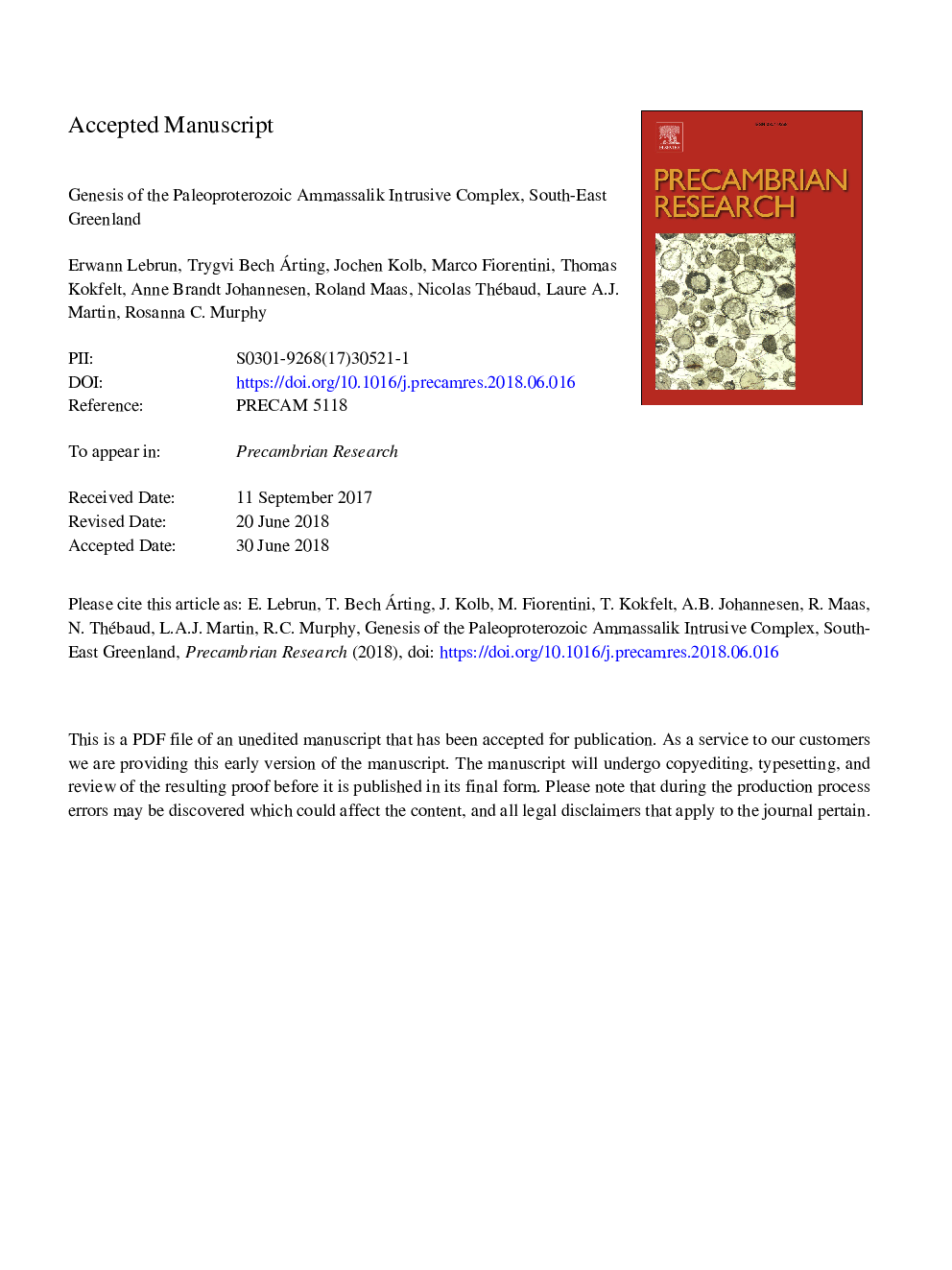| کد مقاله | کد نشریه | سال انتشار | مقاله انگلیسی | نسخه تمام متن |
|---|---|---|---|---|
| 8912469 | 1639560 | 2018 | 71 صفحه PDF | دانلود رایگان |
عنوان انگلیسی مقاله ISI
Genesis of the Paleoproterozoic Ammassalik Intrusive Complex, south-east Greenland
ترجمه فارسی عنوان
پیدایش پالئوپروتروزیوزی آمفاسروک مجله نفوذی، جنوب غربی گرینلند
دانلود مقاله + سفارش ترجمه
دانلود مقاله ISI انگلیسی
رایگان برای ایرانیان
کلمات کلیدی
گرینلند، کلمبیا، قوس قاره، حاشیه کراتون، کانی سازی نیکل سولفید،
موضوعات مرتبط
مهندسی و علوم پایه
علوم زمین و سیارات
ژئوشیمی و پترولوژی
چکیده انگلیسی
The Paleoproterozoic Ammassalik Intrusive Complex of south-east Greenland is located at the margin between the Rae Craton to the north and the North Atlantic Craton to the south. The complex is part of the Nagssugtoqidian Mobile Belt emplaced at mid- to lower-crustal level and represents an eastward continuation of the Nagssugtoqidian Orogen of western Greenland. We present new whole-rock geochemical and isotopic data (whole-rock Rb-Sr, Sm-Nd, U-Pb, Lu-Hf and zircon U-Pb, Lu-Hf, O) acquired from the Ammassalik Intrusive Complex, with the aim of reassessing its petrogenesis and evolution. The intrusive rocks and surrounding host-rocks show typical calc-alkaline signatures as well as negative Ta, Nb and Ti anomalies. The new U-Pb age data indicate a protracted magmatic history over ca. 40â¯Ma, involving at least three successive magmatic pulses between ca. 1910 and 1870â¯Ma emplaced into a granulite facies biotite-garnet paragneiss with ca.â¯â¤â¯1990â¯Ma protolith ages. Whole-rock trace element and isotope geochemistry indicate that the magmas that formed the Ammassalik Intrusive Complex were derived from a mildly enriched (εNd0â¯=â¯â0.8 to -3.8; εSr0â¯=â¯+24 to +42) and deep, garnet-bearing (MREE/HREE fractionated patterns) mantle source, possibly the sub-continental lithospheric mantle. However, the observed decreasing zircon εHf values with time (εHf0â¯=â¯+2.8 to â12.5) indicate increasing degrees of crustal contamination involving variably 18O-enriched crustal material (δ18Oâ¯=â¯7-9â°) into the mafic magmas of the complex. This interpretation suggests that the mantle-derived magma do not have a deep, garnet-bearing source, but that the continental arc signature in the Ammassalik Intrusive Complex igneous rocks may have been inherited from the assimilation of partial melts of the garnet-bearing host-rocks. In addition, based on the new crystallisation ages broadly coeval with the Columbia supercontinent build up, marked by the formation of world-class Ni-Cu deposits globally, it is proposed that the Ammassalik Intrusive Complex and the south-east Greenland region were in direct continuity of the mineralised Kotalahti belt (Svecofennian Province, Finland). Together with the recent discovery of Ni-Cu mineralisation in the Ammassalik Intrusive Complex, our study further supports the high prospectivity of south-east Greenland for orthomagmatic Ni-Cu deposits.
ناشر
Database: Elsevier - ScienceDirect (ساینس دایرکت)
Journal: Precambrian Research - Volume 315, September 2018, Pages 19-44
Journal: Precambrian Research - Volume 315, September 2018, Pages 19-44
نویسندگان
Erwann Lebrun, Trygvi Bech Árting, Jochen Kolb, Marco Fiorentini, Thomas Kokfelt, Anne Brandt Johannesen, Roland Maas, Nicolas Thébaud, Laure A.J. Martin, Rosanna C. Murphy,
